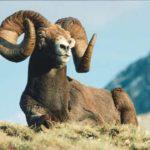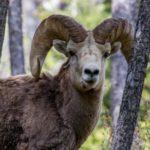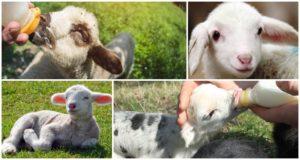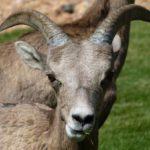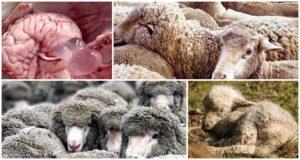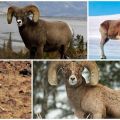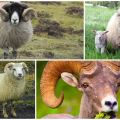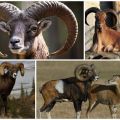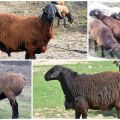Description of Altai mountain sheep and detailed information about the species, breeding
Altai mountain sheep are considered the largest on the planet. They have significant differences from those animals that many people are used to seeing. The mass of a lamb can be 180 kilograms. At the same time, only one horns account for 35 kilograms. This variety is considered very rare. Therefore, international organizations are taking measures to save the population.
Description of the Altai ram
These rams are large and well proportioned. In height, males at the withers grow up to 122 centimeters, and females - up to 114. The weight of males reaches 200 kilograms, while females weigh 103. These animals with large horns have a spectacular appearance. In old males, they reach 151 centimeters. Moreover, the girth at the base reaches 55 centimeters, and the weight is 22 kilograms.
The horns of animals have important biological functions. They provide protection from predatory animals. Also, this part of the body is used by males to fight for the right to mate during the reproductive period.
Habitat
Today there are 3 distinct populations of animals. They are located on the border of Mongolia and China, on the Saigul ridge and in mountainous regions near the upper reaches of the Chulyshman River. Most often, rams live in mountain steppes near the foot of the ridges. They also settle on open slopes at an altitude of 2-3 thousand meters above sea level. There is no forest vegetation in these places.

The number of individuals and the reasons for the decline in the population
At the beginning of the last century, the number of mountain sheep was 600 individuals. A little later, their number suddenly decreased to 245. With the help of special protective measures and the relocation of adult animals to reserves, their number was slightly increased to 320.
The main reasons for the decline in the number of animals include the following:
- Human influence on ecology. Today, Altai sheep are gradually being ousted from their usual places. In these areas, people graze domestic goats or yaks. Therefore, wild individuals are forced to look for new places.
- Poaching. Although Altai rams are considered protected animals, some of them are still shot. This occurs throughout the habitat of individuals.
- Deteriorating climate.Over the past decades, climatic conditions have deteriorated more and more. The lack of food negatively affects the animal population, which leads to their death in the winter.
Social structure and breeding period
Mountain rams are considered calm animals. They are not aggressive towards other species. The lambs that live in the herd constantly follow each other and feel the need to communicate with their relatives. The rutting period for animals begins in October and ends in mid-January. In individuals who live closer, this stage is considered longer. Sheep are polygamous. Males arrange battles, colliding with horns for the right to mate with a female.
In females, maturity occurs at 2 years old, and in males only at 5 years old. After the establishment of domination, the rams approach the females. Mating takes place 2-3 weeks after the start of the rut. Sometimes it is carried out within 2 months after the end of this period.
Pregnancy in females lasts just over 165 days. Cubs are born in late March or April. Most often, 1 lamb is born. However, twins are sometimes born. In rare cases, up to 5 babies may be born. Newborn cubs weigh 2700-4600 grams. They gain weight quickly. Already by 1 year, it increases 10 times. Females gain maximum weight by the age of two, and males grow for another 2 years.

The diet
These rams are considered herbivores. Herbs and greens are considered the basis of their diet. Females and young rams live in mountainous areas, where the quality of food is much worse than on the plains. Adults choose places much lower for feeding. There is a lot of quality food there.
Altai sheep have managed to adapt to life in extreme conditions - they are able to withstand wind and drought.
On average, the daily amount of food is 16-19 kilograms. In this case, the diet changes taking into account the height and area of the area. In the highlands, the diet is based on grass and sedge. At the middle level, there are shrubs and herbs on the menu. Individual habitats include shoots, flowers, leaves, and fruits.
Altai rams need water. Individuals that live in the highlands have no problem with this. If animals live in arid areas, they are able to travel long distances to find water.
Enemies of argali in the natural environment
Adult females are large and can run fast. Therefore, they do not need special protection from predators. Therefore, they can live near the plains. At the same time, females and young lambs need to live higher. Sometimes they are able to defend themselves with horns.
In their natural environment, Altai rams encounter the following predators:
- grey Wolves;
- cheetahs;
- leopards;
- snow leopards;
- Snow leopards.
Small lambs suffer from coyotes. Also, even some birds of prey are capable of attacking them. Eagles and golden eagles represent the key danger. To avoid threats from predatory animals, rams are forced to move in herds and keep in groups.

Breeding the breed
They tried to breed these animals in zoos in America and Germany. However, these attempts were unsuccessful. Usually the lambs died after several months or even days. As long as possible, these individuals were able to live in captivity at the Biological Institute, located in Siberia. Their lifespan was 6 years. It is recommended to keep Altai sheep close to their natural habitat. At the same time, it is important to create suitable conditions for them and provide quality care.
The rocks need to stick together to form large herds. In this case, the females always go separately, and the males must do this in such a way as to protect the young.
What is WWF doing to conserve argali?
For many years this organization has been taking measures to preserve the population of Altai sheep on the territory of Russia. The Foundation conducts anti-poaching activities, carries out relevant research and keeps animal records. WWF specialists take part in the creation of materials and programs aimed at protecting the species in Russia. They help to make protected areas in animal habitats.
According to WWF information, since 2003 the number of animals in the transboundary zone of Mongolia and Russia has been stable. Altai mountain sheep are a breed that is on the verge of extinction. Unique sizes are considered to be the main feature of animals. Representatives of this species are distinguished by impressive weight and voluminous horns. They live on high cliffs and need protection from nature conservation organizations.
